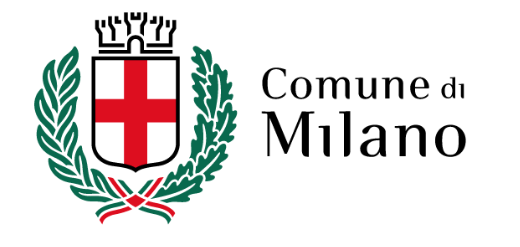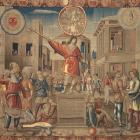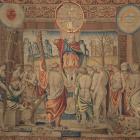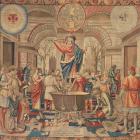- Milan Castle
- Museums Libraries Archives
- Museo Pietà Rondanini - Michelangelo
- Museo d'Arte Antica
- Sala delle Asse - Leonardo da Vinci
- Pinacoteca
- Museo dei Mobili e delle Sculture Lignee
- Museo delle Arti Decorative
- Museo degli Strumenti Musicali
- Museo Archeologico - Sezione Preistoria e Protostoria
- Museo Archeologico - Sezione Egizia
- Raccolta delle Stampe "Achille Bertarelli"
- Gabinetto dei Disegni
- Archivio Fotografico
- Archivio Storico Civico e Biblioteca Trivulziana
- Biblioteca d'Arte
- Biblioteca Archeologica e Numismatica
- Casva (Centro di Alti Studi sulle Arti Visive)
- Ente Raccolta Vinciana
- Gabinetto Numismatico e Medagliere
- Opere dei musei in movimento
- The Castle and Milan
- Media gallery
- Plan your own tour

Bramantino
The Trivulzio Tapestries
The highlight of the Balla Room is an extraordinary cycle of tapestries representing the twelve months of the year. Commissioned by Gian Giacomo Trivulzio, nominated Marshall of France and Governor General of Lombardy by the French authorities in 1499, the cycle was designed by Bartolomeo Suardi, better known as il Bramantino (before 1480 after 1530) and woven in Vigevano by Benedetto da Milano and his assistants. The complex endeavour was completed in 1509. Due to the state of conservation and integrity of the tapestries, which at their centre have a representation of each month surrounded by figures carrying out the according agricultural activities, they are considered to be of particular importance. Within a garland at the centre-top of the tapestry is the Trivulzio coat of arms, depicting a mermaid in the act of breaking a file on a diamond, a clear allusion to the indestructible solidity of the client, underscored by the motto, Netes mai, the phonetic transliteration of Ne t'esmai (never fear). On either side of the garlanded coat of arms are the sun and the relevant zodiac sign. Coats of arms and monograms of the Trivulzio family frame the scenes. Combining a technique more typical of Northern Europe with an Italian Renaissance sensibility and composition, the twelve hangings follow the solar cycle, starting in March and ending in February. In the month of February one can make out the man who commissioned the work, Gian Giacomo Trivulzio and his spouse Beatrice d'Avalos, while Donato Bramante, the great Renaissance artist is portrayed in the month of August.
The tapestries are on display in the Balla Room, Room XXXVII of the Museum of Musical Instruments.













